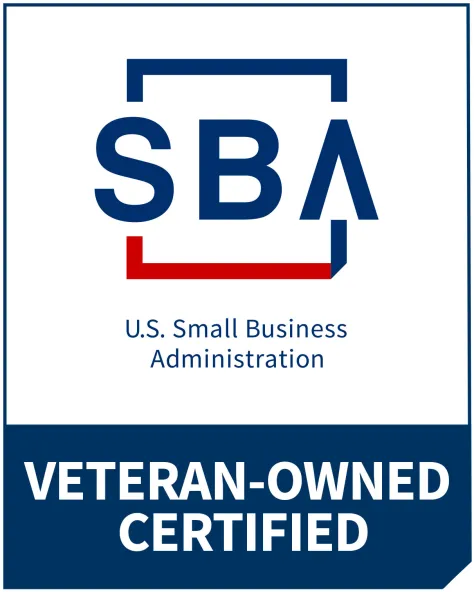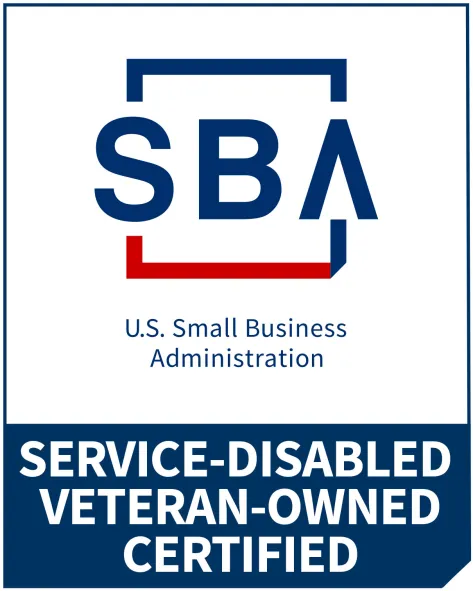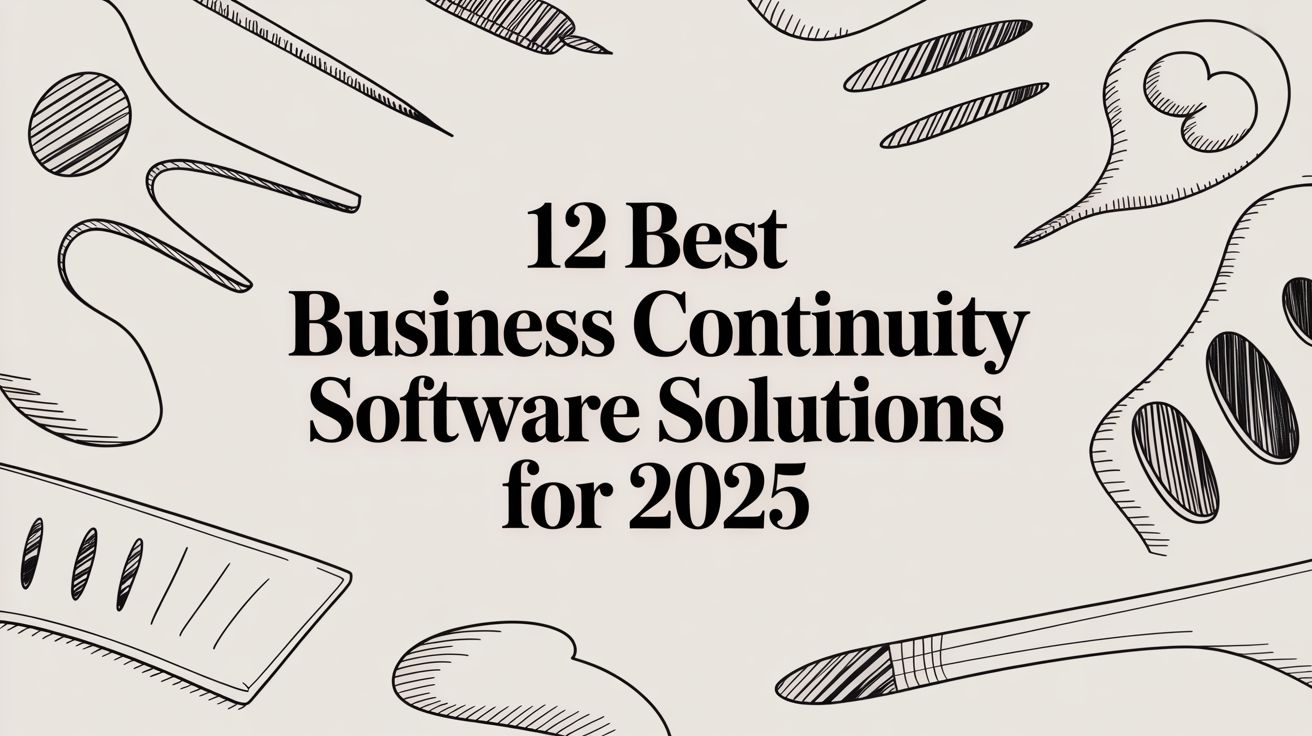In an era of constant digital threats and unforeseen disruptions, maintaining operational uptime isn't just an IT goal-it's a core business imperative. A minor outage can cascade into significant financial loss, reputational damage, and regulatory penalties, especially for organizations in regulated fields like healthcare and finance. This is where a strategic investment in business continuity management (BCM) software becomes essential, shifting your organization from a reactive to a proactive resilience model.
But with a crowded market of platforms, how do you choose the right one for your specific needs? This guide cuts through the noise. We will analyze the 12 best business continuity software solutions, evaluating them not just on features, but on real-world applicability, implementation hurdles, and specific use cases. Each review includes direct links and screenshots to give you a clear view of the platform.
Whether you're an SMB in San Antonio needing a managed BCDR solution from a partner like Defend IT Services or a multi-location enterprise requiring a comprehensive, GRC-integrated platform, this resource provides the detailed insights you need. Our goal is to help you make an informed decision to build a truly resilient organization capable of weathering any storm.
1. Defend IT Services — Managed Backup & Disaster Recovery (BCDR) for SMBs
As our top choice, Defend IT Services offers a distinct and powerful approach to business continuity, positioning it as more than just software but a comprehensive managed service. Tailored specifically for small and medium-sized businesses (SMBs), this solution stands out by combining industry-leading technology, like Datto, with a hands-on, security-first management philosophy. This integrated model ensures not only that the tools are robust but that they are expertly deployed, monitored, and managed 24/7 to guarantee rapid recovery and minimal operational disruption.
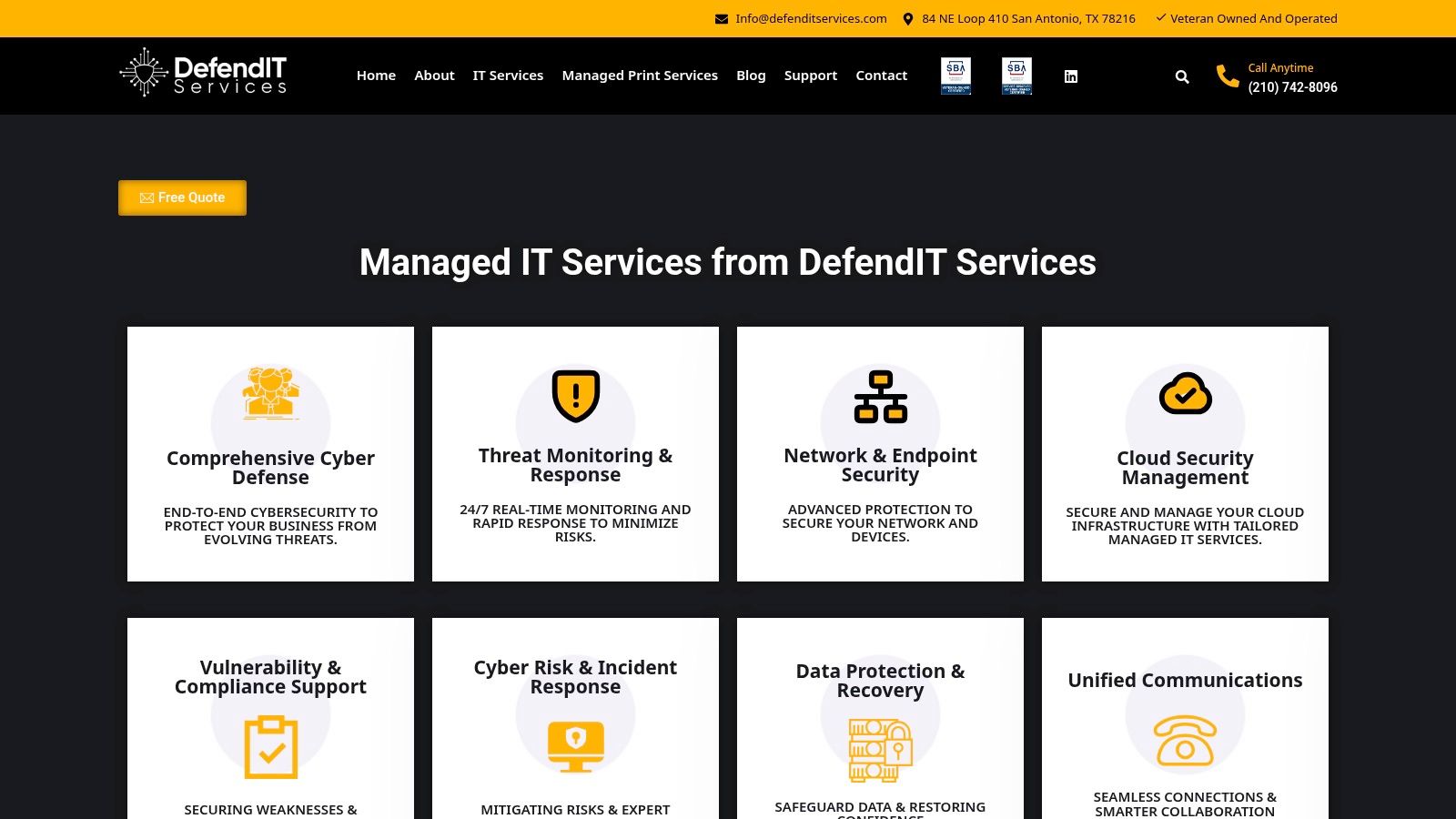
Unlike a purely software-based solution, Defend IT's BCDR service provides a strategic partnership. The team, comprised of veteran IT professionals, creates a customized roadmap aligned with specific business needs and regulatory frameworks like HIPAA, PCI-DSS, and GDPR. This makes it an ideal choice for organizations in regulated industries that cannot afford compliance gaps. The proactive monitoring and rapid response capabilities mean threats are neutralized and systems are restored often before the business even feels the impact.
Key Strengths & Use Cases
Defend IT’s managed BCDR solution is particularly effective for businesses that lack a dedicated internal IT security team. By outsourcing this critical function, SMBs gain access to enterprise-grade expertise and infrastructure without the associated overhead.
- Best For: SMBs, especially in regulated sectors like healthcare and finance, that require guaranteed uptime and verified compliance.
- Standout Feature: The combination of 24/7 proactive monitoring and a hands-on, expert-led implementation sets it apart from DIY software solutions.
- Practical Application: A medical clinic can leverage this service to ensure its patient data is backed up in a HIPAA-compliant manner and can be restored almost instantly after a ransomware attack, avoiding critical downtime and regulatory penalties.
For a deeper dive into their integrated approach, you can explore why San Antonio businesses need managed cybersecurity services.
Pros & Cons
| Pros | Cons |
|---|---|
| 24/7 proactive monitoring and rapid recovery minimize downtime. | Primarily targeted toward SMBs, potentially limiting its fit for large enterprises. |
| Fully managed backups ensure compliance with HIPAA, PCI-DSS, and GDPR. | Requires an initial consultation to tailor the solution, as it is not an off-the-shelf product. |
| Leverages trusted, industry-leading BCDR technology from partners like Datto. | |
| Provides customized, hands-on service from a veteran-owned, local provider. | |
| Integrates with broader managed services for holistic operational continuity. |
Visit Defend IT Services Website
2. ServiceNow – Business continuity Management
For organizations already embedded in the ServiceNow ecosystem for ITSM, ITOM, or GRC, the Business Continuity Management (BCM) module is a powerhouse. It transforms your existing Configuration Management Database (CMDB) and workflows into a central hub for operational resilience. This isn't just another bolt-on tool; it’s a deeply integrated solution that leverages a single data model, making it some of the best business continuity software for enterprise-level consolidation.
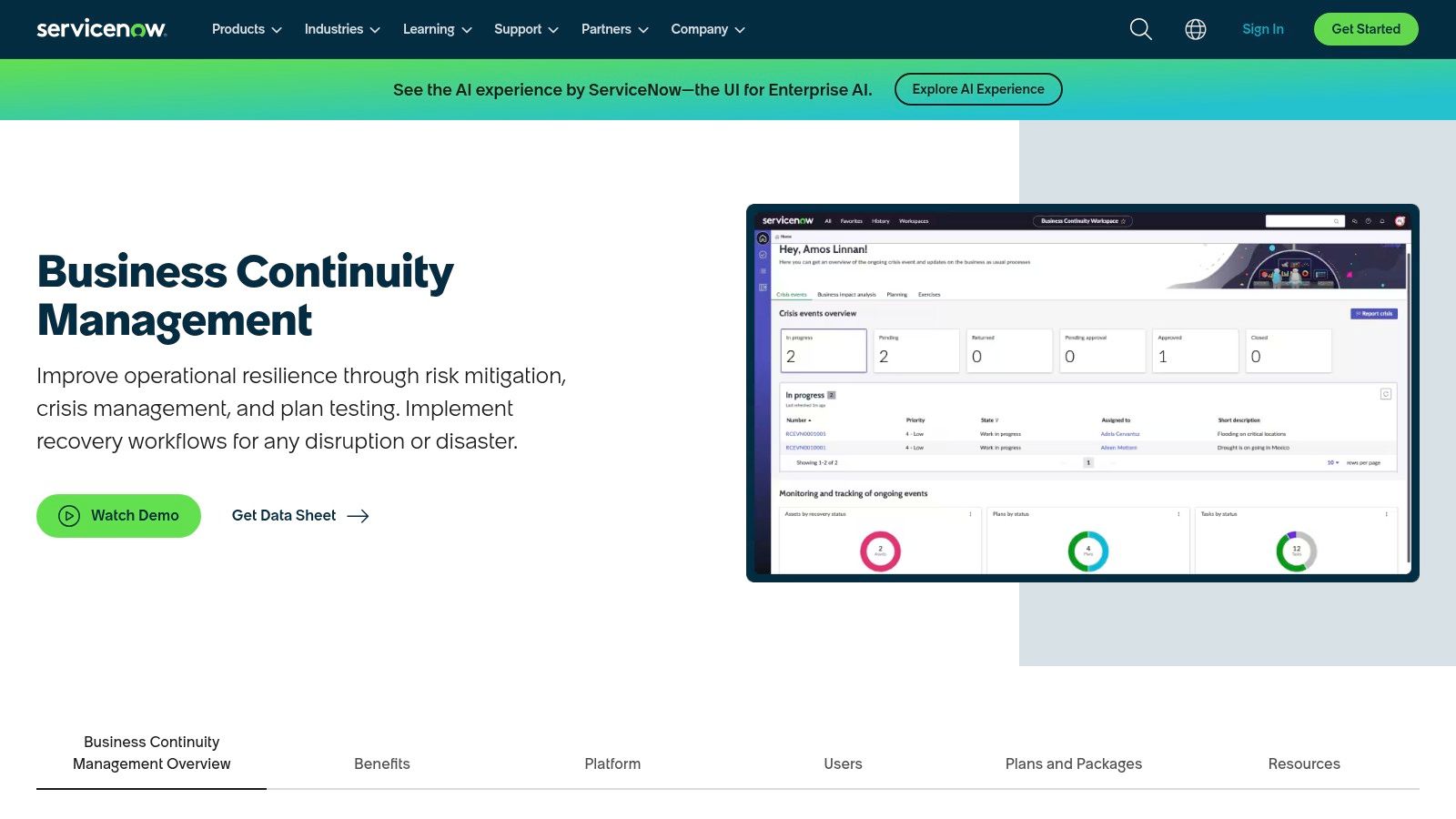
The platform excels at connecting disparate risk, continuity, and recovery processes. You can conduct Business Impact Analyses (BIAs) that are directly tied to your IT asset inventory, author recovery plans, and manage crisis exercises all within a unified interface. When a disruption occurs, its integrated mass notification system can reach stakeholders across more than 25 different channels, while task orchestration automates critical recovery steps.
Our Take
Defend IT Services View: The true value of ServiceNow BCM emerges when it's part of a broader ServiceNow strategy. For a business in San Antonio that uses ServiceNow for help desk and asset management, we can deploy this module to create a seamless link between an IT outage ticket and the activation of a business continuity plan, providing unparalleled visibility and control for regulated industries like finance or healthcare.
| Feature Highlights | Assessment |
|---|---|
| Native Integration | Excellent. Unifies BCM with ITSM, CMDB, and GRC workflows on a single platform. |
| Crisis Management | Robust. Includes exercise management and automated crisis activation with task orchestration. |
| Ease of Adoption | Moderate. Onboarding can be complex if you're not an existing ServiceNow customer. |
Website: https://www.servicenow.com/products/business-continuity-management.html
3. Fusion Risk Management – Fusion Framework System
As a long-standing leader in operational resilience, Fusion Risk Management offers a highly mature platform built on Salesforce Lightning. The Fusion Framework System is designed for organizations that need to map complex, end-to-end dependencies between processes, applications, and assets. Its strength lies in providing a holistic view of risk and continuity, making it some of the best business continuity software for large enterprises managing sophisticated operational environments.
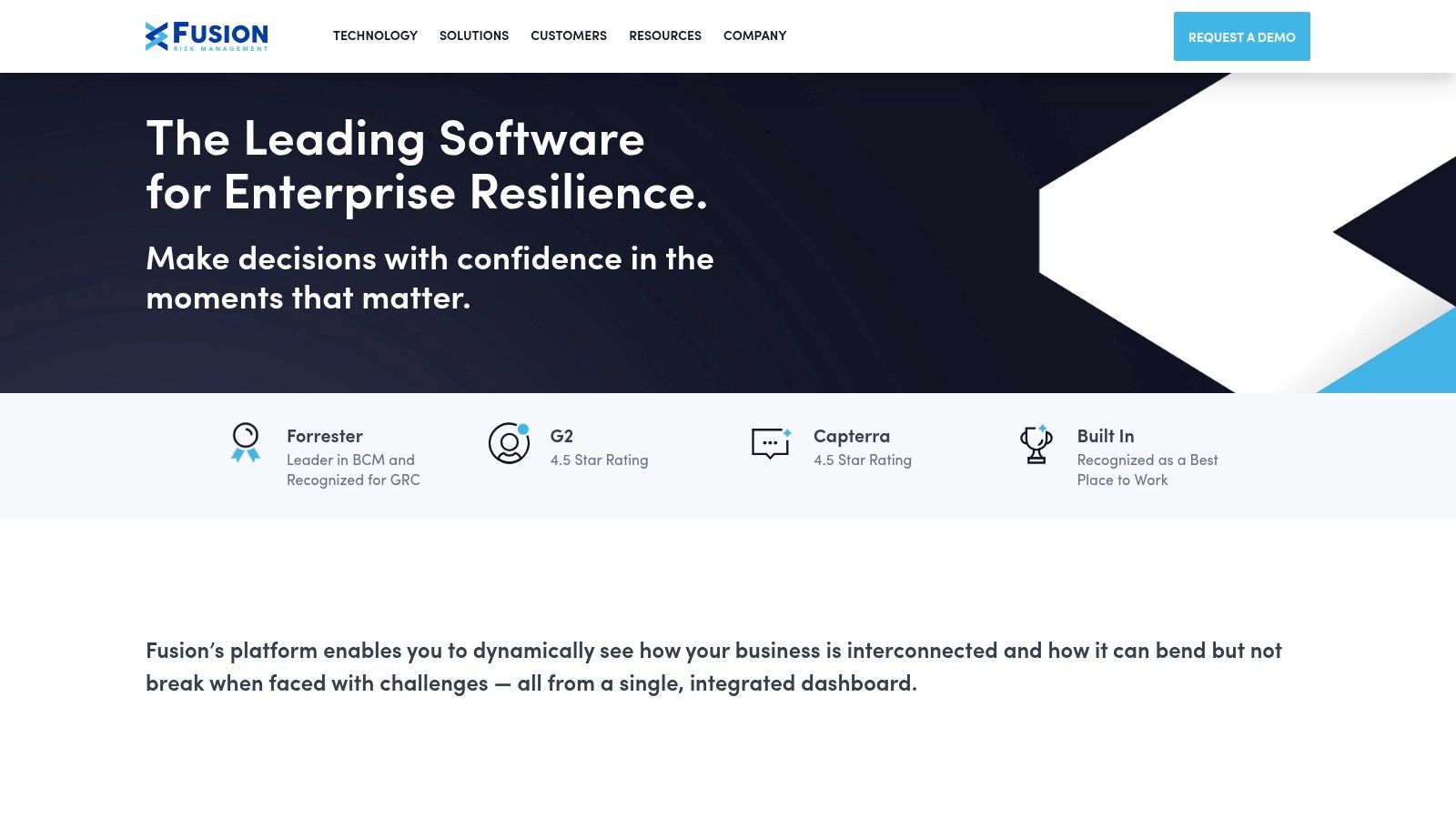
The platform is renowned for its visual dependency mapping, which allows teams to clearly see how a disruption to one IT system could cascade across business services. It supports the full BCM lifecycle, from Business Impact Analysis (BIA) and risk assessments to detailed response orchestration and exercise management. Its ability to coordinate IT disaster recovery alongside business-level continuity plans in a single framework is a key differentiator.
Our Take
Defend IT Services View: Fusion's configurability is its greatest asset. For a San Antonio-based manufacturer with intricate supply chains and production dependencies, we can use the Fusion Framework to model every critical point of failure. This allows us to build hyper-specific recovery playbooks that aren't just theoretical but are directly tied to the real-world operational flow, ensuring compliance and minimizing downtime.
| Feature Highlights | Assessment |
|---|---|
| Dependency Mapping | Excellent. Superior visual tools for mapping complex process and asset relationships. |
| Program Maturity | Robust. Offers comprehensive workflows suitable for mature, enterprise-level BCM programs. |
| Ease of Adoption | Moderate. The depth of its configuration options can require dedicated administrator time and expertise to fully leverage. |
Website: https://www.fusionrm.com/
4. Everbridge – BC in the Cloud (Infinite Blue) and Crisis Management
Following its acquisition of Infinite Blue, Everbridge now offers a comprehensive platform that merges its Critical Event Management (CEM) leadership with robust BCM capabilities. The result is a solution ideal for organizations wanting to unify crisis management, mass notifications, and continuity planning under a single vendor. This integration makes it some of the best business continuity software for businesses that need to manage the entire lifecycle of a disruptive event, from initial risk intelligence to full operational recovery.
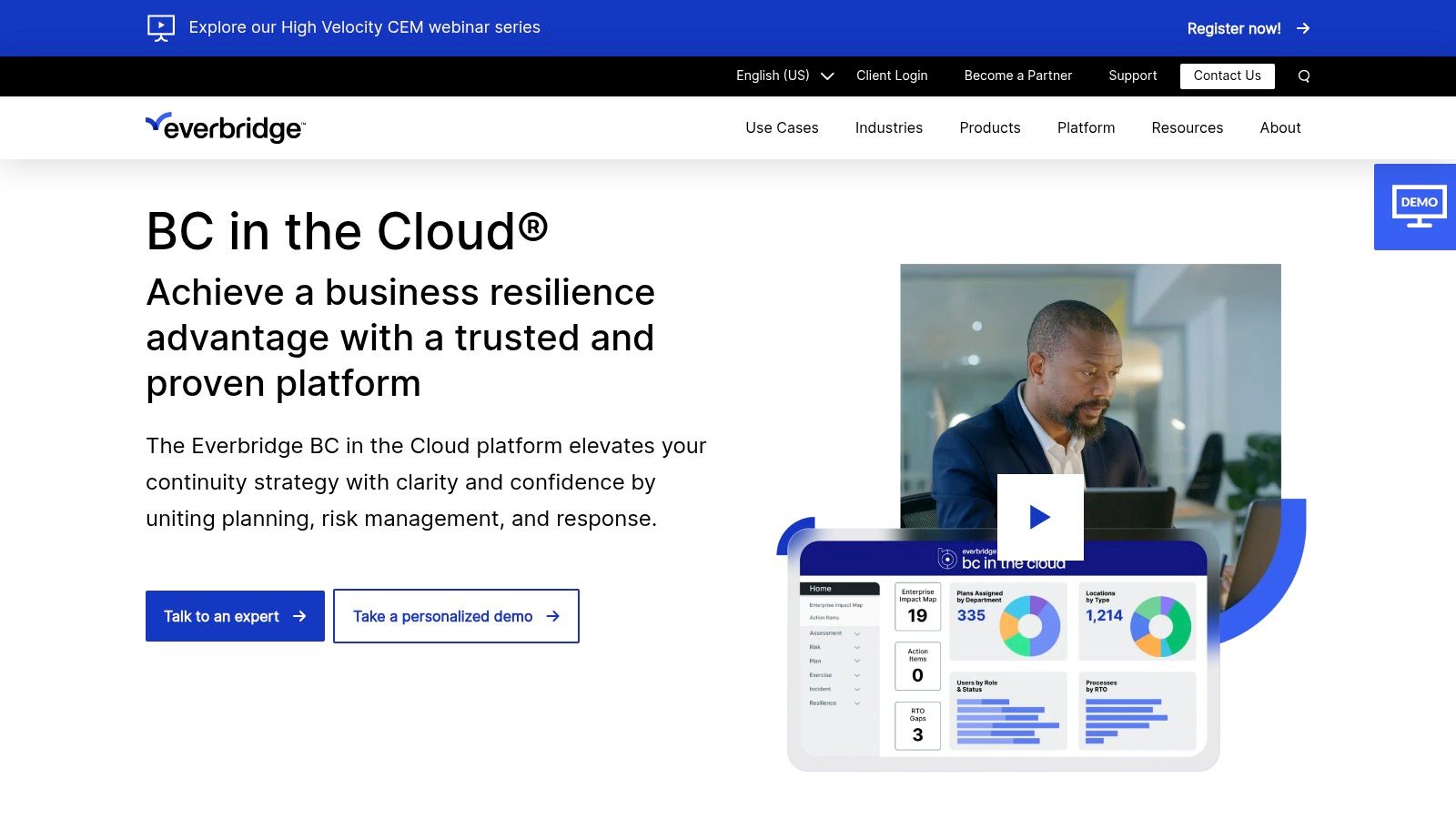
The platform stands out with its low-code plan templates and workflows designed for regulatory compliance, including support for DORA. During an incident, real-time dashboards provide a common operating picture, while the integrated notification system ensures critical communications are delivered effectively. This synergy allows teams to not only plan for disruptions but to actively command and control the response when one occurs, closing the gap between strategy and execution.
Our Take
Defend IT Services View: For San Antonio businesses that see continuity as part of a larger risk and resilience strategy, Everbridge is a top contender. We can leverage its combined CEM and BCM features to ensure that when a physical or cyber threat is detected, the right plans and people are activated instantly. This holistic approach is crucial, and it aligns with the broader principles of cybersecurity for growing businesses.
| Feature Highlights | Assessment |
|---|---|
| CEM + BCM Integration | Excellent. A unified platform for risk intelligence, crisis communication, and recovery planning. |
| Compliance Readiness | Strong. Offers specific templates and workflows for regulations like DORA and resilience testing. |
| Scalability | Moderate. The extensive feature set might be overly complex for smaller, less mature BCM programs. |
Website: https://www.everbridge.com/products/bc-in-the-cloud-everbridge/
5. Riskonnect – Business Continuity & Resilience
Riskonnect brings a holistic, integrated risk management (IRM) perspective to business continuity, which was significantly enhanced by its acquisition of Castellan Solutions. It positions business continuity not as a standalone function but as a core component of a broader organizational resilience strategy. This makes it some of the best business continuity software for enterprises seeking to consolidate risk, continuity, crisis management, and threat intelligence into a single, cohesive suite.
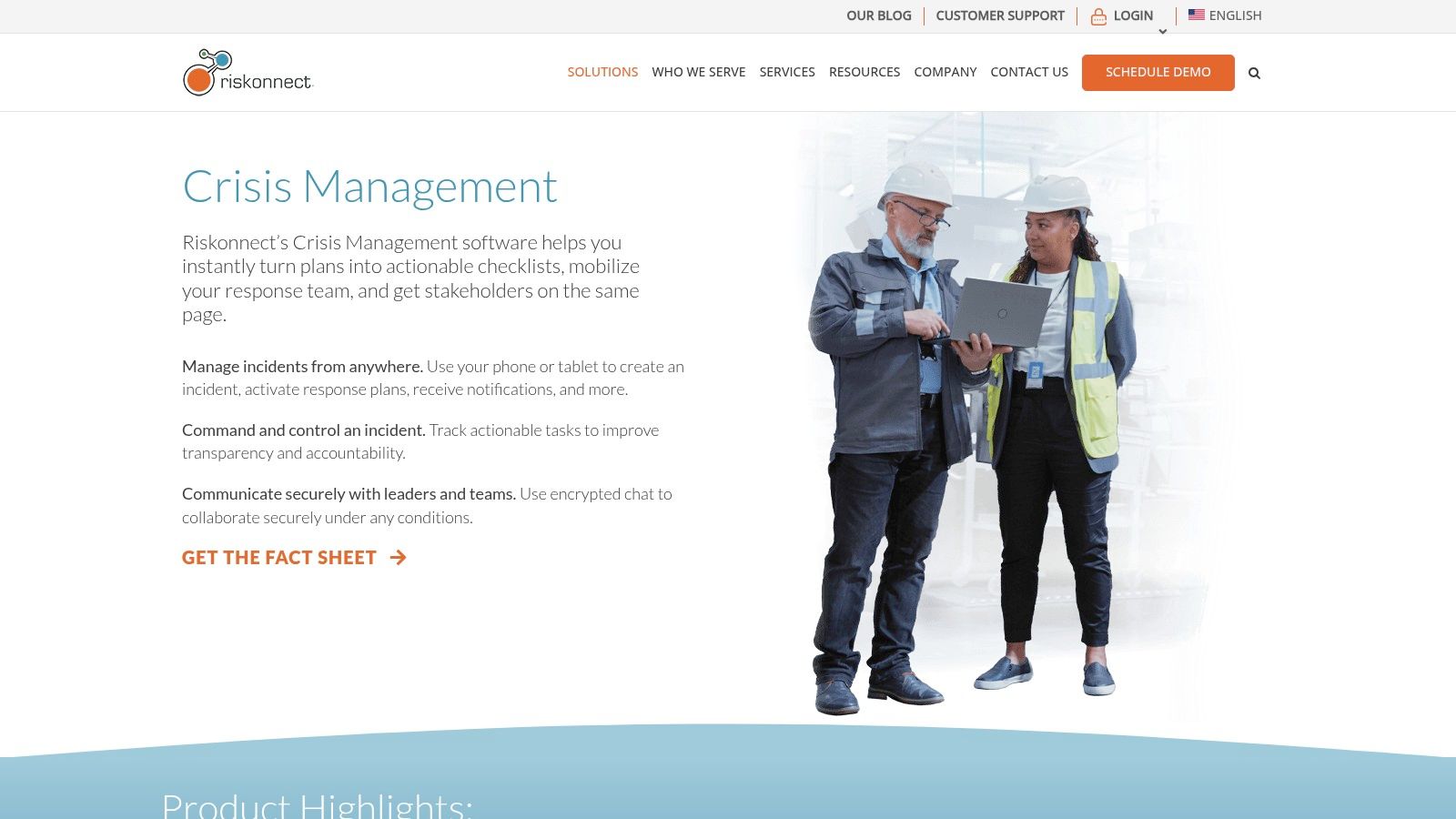
The platform shines in its crisis management capabilities, offering mobile incident command centers that empower response teams in the field. It integrates real-time threat intelligence feeds to provide automated alerts, allowing for proactive risk mitigation. A standout feature is its use of generative AI to assist in creating initial drafts of BCP and BIA content, which can dramatically speed up the documentation process and reduce manual effort for teams.
Our Take
Defend IT Services View: For San Antonio businesses that view BCM as part of a larger GRC framework, Riskonnect is a top contender. Its integrated approach means a supply chain risk identified in one module can automatically trigger a review of associated business continuity plans. We leverage this to give our clients a 360-degree view of operational threats, moving them from reactive recovery to proactive resilience.
| Feature Highlights | Assessment |
|---|---|
| IRM & BCM Convergence | Excellent. A unified platform for managing risk, continuity, and crisis response. |
| Mobile Crisis Management | Robust. Powerful mobile apps and incident command features for on-the-go teams. |
| Ease of Adoption | Moderate. The comprehensive nature of the platform may feel heavy for organizations with simple BCM programs. |
Website: https://riskonnect.com/solutions/business-continuity-software/crisis-management-software/
6. SAI360 – Business Continuity Management (within SAI360 GRC)
SAI360 offers a Business Continuity Management module that is deeply integrated into its broader Governance, Risk, and Compliance (GRC) platform. Drawing from the heritage of proven tools like ResilienceONE, it provides a connected view of resilience, linking your BCM activities directly to enterprise risk management (ERM) and third-party risk. This approach makes it some of the best business continuity software for organizations looking to mature their resilience program beyond isolated planning into a holistic risk-aware strategy.
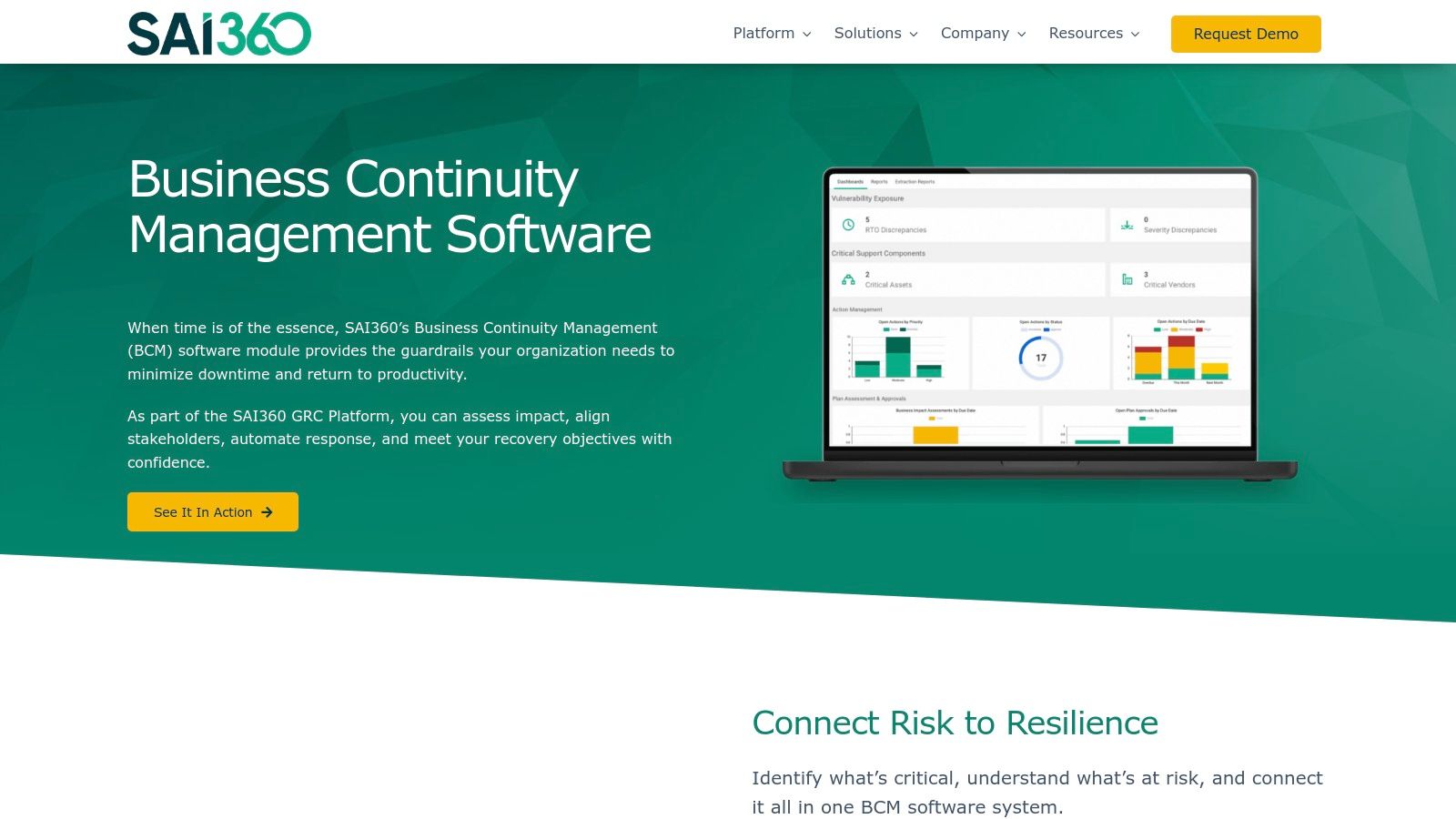
The platform is designed for faster implementation through its "FastStart" methodology, using preconfigured modules to accelerate deployment. Users can conduct thorough BIAs, build continuity plans, and activate crisis management or IT disaster recovery protocols from a central command center. Its strength lies in providing executive dashboards that visualize continuity readiness in the context of overall organizational risk and compliance posture.
Our Take
Defend IT Services View: For San Antonio businesses that need to demonstrate resilience to regulators or board members, SAI360's GRC integration is a key differentiator. We can implement this solution to not only build robust recovery plans but also to connect those plans to specific compliance controls and identified enterprise risks. This creates a powerful, auditable trail showing how your continuity strategy supports overall business objectives, which is a core reason why San Antonio businesses trust DefendIT Services for cybersecurity.
| Feature Highlights | Assessment |
|---|---|
| Broad GRC Integration | Excellent. Connects BCM data directly to ERM, compliance, and vendor risk modules. |
| Implementation Speed | Good. Preconfigured "FastStart" modules aim for a quicker time-to-value. |
| User Interface | Moderate. The interface can present a learning curve for new users, according to some reviews. |
Website: https://www.sai360.com/solutions/business-continuity-management
7. Archer – Business Resiliency / Resilience Management
For organizations with mature risk management programs, Archer’s Business Resilience solution offers a top-down, governance-focused approach. Stemming from its deep roots in Integrated Risk Management (IRM), Archer excels at linking business continuity planning directly to corporate risk, compliance, and audit functions. This makes it some of the best business continuity software for enterprises that need to demonstrate resilience to regulators and board members, not just recover from incidents.
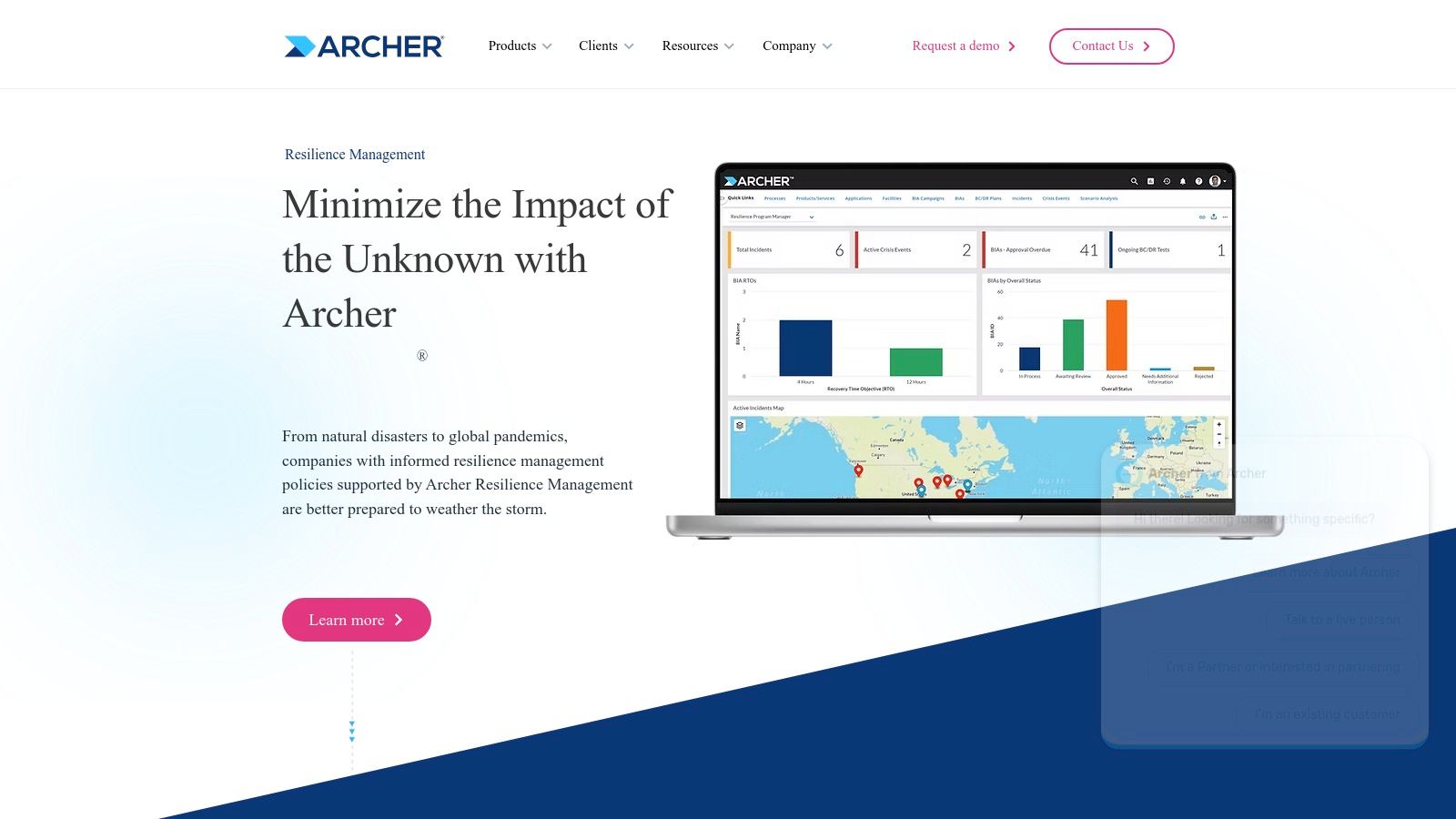
The platform provides a single, authoritative repository for conducting Business Impact Analyses (BIAs), documenting recovery plans, and tracking test results. Its strength lies in its structured workflows for crisis management and impact tolerance analysis, ensuring that every continuity action is auditable and aligned with enterprise policy. This rigorous framework is ideal for heavily regulated sectors where proof of compliance is paramount.
Our Take
Defend IT Services View: Archer is a strategic tool, not just an operational one. For a San Antonio financial institution needing to prove its operational resilience to the OCC or FFIEC, we would leverage Archer to build an airtight program. It connects the dots between a server outage (ITDR), the affected business processes (BCM), and the overall impact on the bank's risk posture, providing comprehensive reporting for auditors.
| Feature Highlights | Assessment |
|---|---|
| IRM Integration | Excellent. Natively connects business continuity to broader risk and compliance programs. |
| Audit & Reporting | Robust. Powerful reporting capabilities designed for regulatory scrutiny and executive oversight. |
| Ease of Adoption | Moderate. Requires dedicated administrative resources and program design for successful implementation. |
Website: https://www.archerirm.com/content/business-resilience
8. LogicManager – Business Continuity Management Program
LogicManager takes a governance-first approach to resilience, positioning its platform as a risk-based program rather than just a planning tool. It stands out with a transparent, fixed-price model that provides unlimited user access based on roles, eliminating the per-seat costs that can stifle adoption in other systems. This makes it some of the best business continuity software for organizations that need to involve a wide range of stakeholders in the BCM lifecycle without worrying about escalating subscription fees.
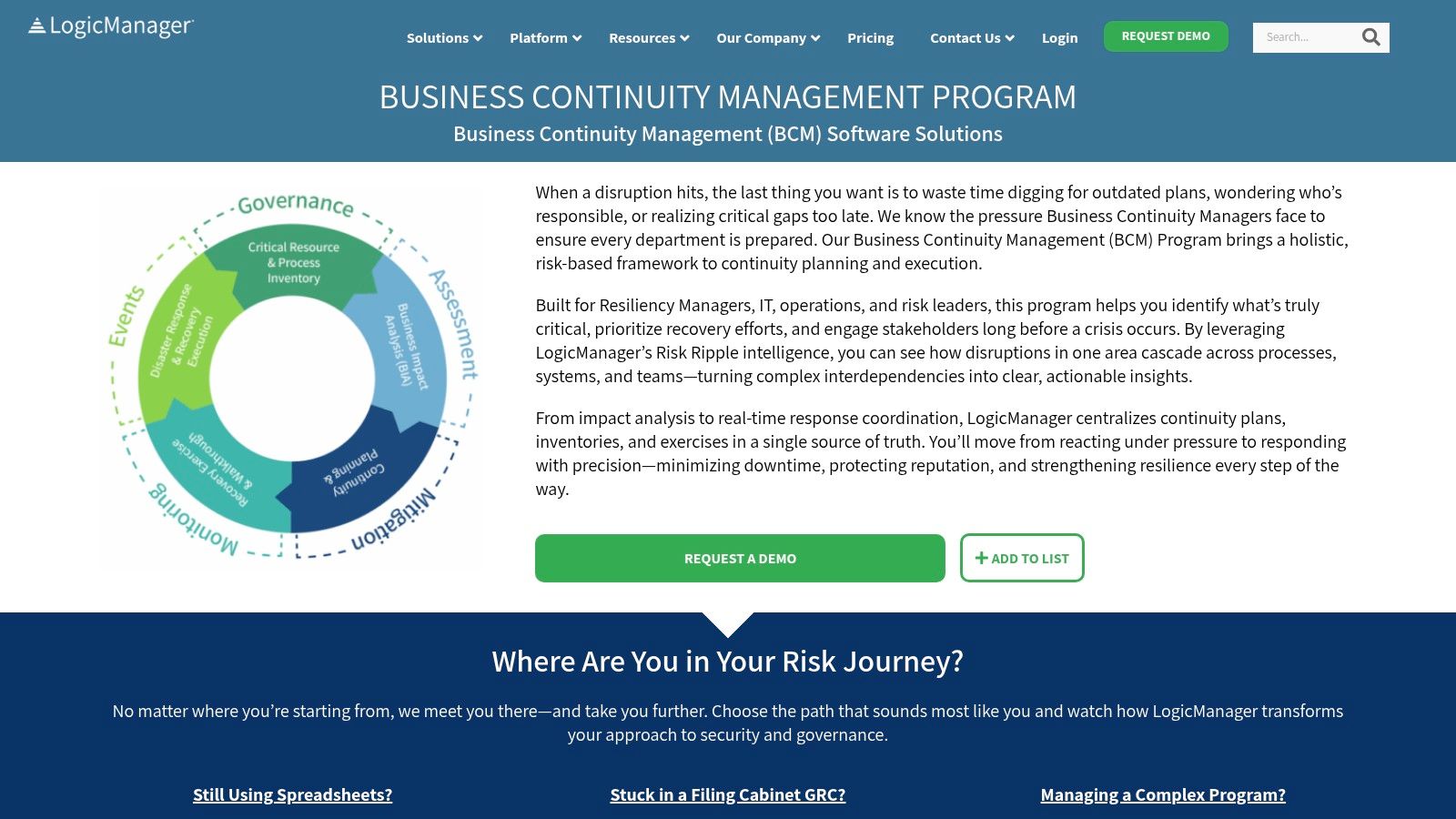
The platform is built around a risk-based methodology, helping you connect every Business Impact Analysis (BIA), recovery plan, and tabletop exercise back to your organizational risk framework. It includes robust workflow automation, reporting, and a library of advisory resources and learning content. While it lacks some native mass notification features found in competitors, it integrates with specialized communication tools to trigger alerts during an event, focusing its core strength on the planning and governance aspects of continuity.
Our Take
Defend IT Services View: LogicManager's model is ideal for a growing San Antonio healthcare practice that needs to empower department heads to own their BCPs while maintaining centralized oversight for HIPAA compliance. We appreciate its emphasis on hands-on advisory and support, which helps clients build a mature, defensible continuity program-not just a set of documents.
| Feature Highlights | Assessment |
|---|---|
| Risk-Based Methodology | Excellent. Tightly integrates BCM activities with enterprise risk management. |
| Pricing Model | Strong. Fixed-price, role-based access encourages widespread user adoption. |
| Native Communications | Moderate. Relies on integrations for advanced mass notification capabilities. |
Website: https://www.logicmanager.com/solutions/business-continuity-management/
9. MetricStream – Business Continuity Management
MetricStream situates its Business Continuity Management (BCM) capabilities within a comprehensive Connected GRC (Governance, Risk, and Compliance) framework. This approach is ideal for enterprises that need to align their resilience strategies with broader risk management, third-party vendor assessments, and regulatory compliance mandates. It provides a centralized command center for BIA, plan development, and crisis management, making it some of the best business continuity software for organizations seeking a holistic view of operational risk.
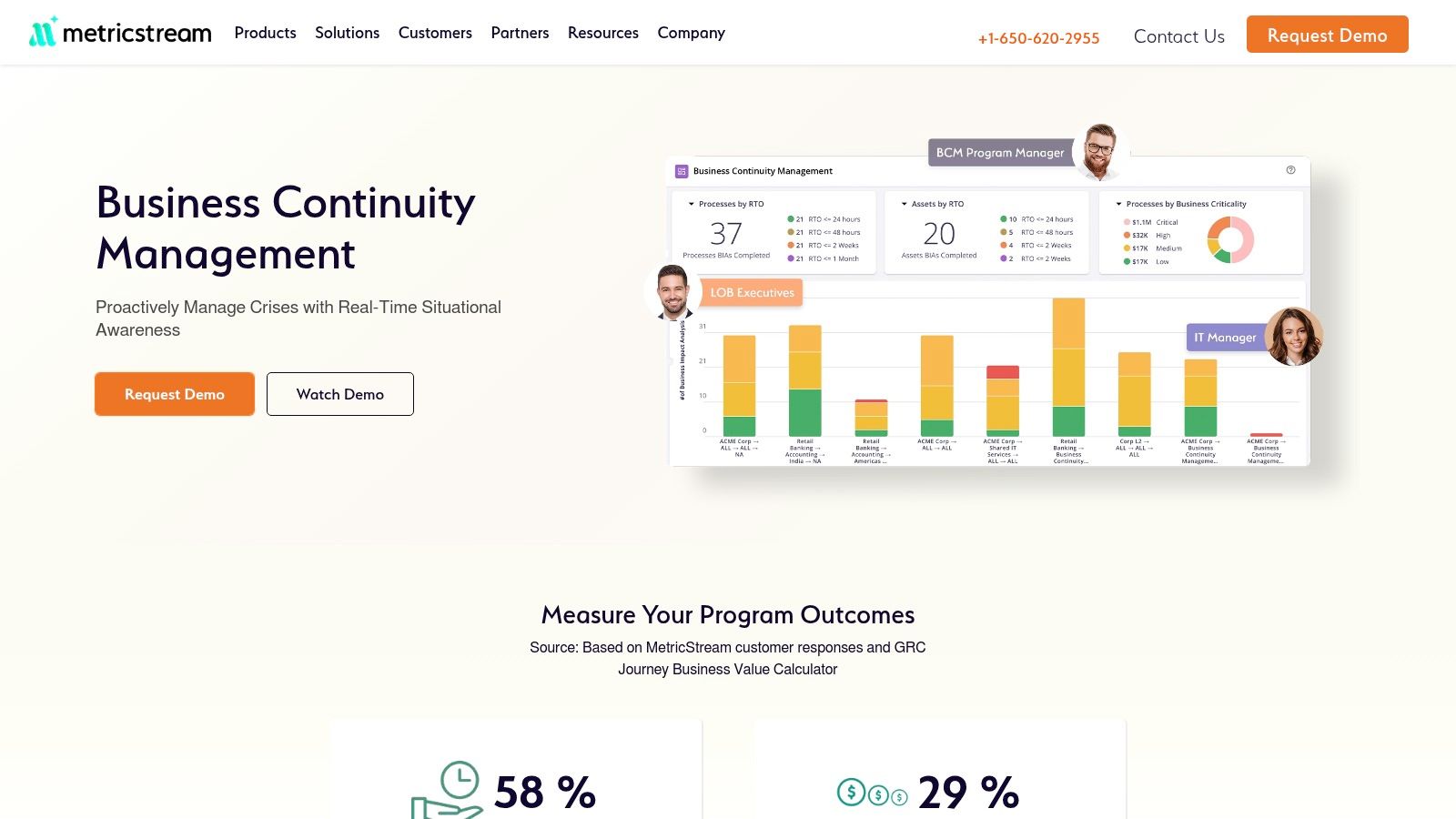
The platform offers robust features, including dependency mapping to visualize critical relationships, configurable plan templates, and detailed RTO/RPO analysis. During a disruption, its emergency notification system and defined crisis declaration workflows ensure a structured response. Mobile access and AI-assisted issue management also empower teams to act decisively from anywhere, which is a significant advantage for distributed workforces.
Our Take
Defend IT Services View: For a San Antonio financial firm needing to prove its resilience to auditors, MetricStream is a powerful choice. We can leverage its GRC integration to directly link a failed business process to specific compliance controls and third-party vendor risks. This creates a clear, auditable trail that shows how business continuity is an integral part of the company's overall governance strategy, not just an isolated IT function.
| Feature Highlights | Assessment |
|---|---|
| Connected GRC Integration | Excellent. Seamlessly ties BCM to risk, compliance, and third-party management. |
| Analytics & Reporting | Robust. Provides extensive dashboards and analytics for enterprise-wide risk visibility. |
| Scalability | Moderate. The enterprise-grade scope may be overly complex and costly for SMBs. |
Website: https://www.metricstream.com/products/business-continuity-management.htm
10. Noggin – Business Continuity Software
Noggin presents an integrated platform that extends beyond traditional BCM to encompass broader operational resilience, including crisis and emergency management. Recognized for its usability, the software provides configurable, modular workspaces that allow organizations to tailor the tool to their specific resilience needs. This approach makes it some of the best business continuity software for businesses seeking a single solution for BCM, crisis management, and incident response, which can be procured directly or via the AWS Marketplace for streamlined deployment.
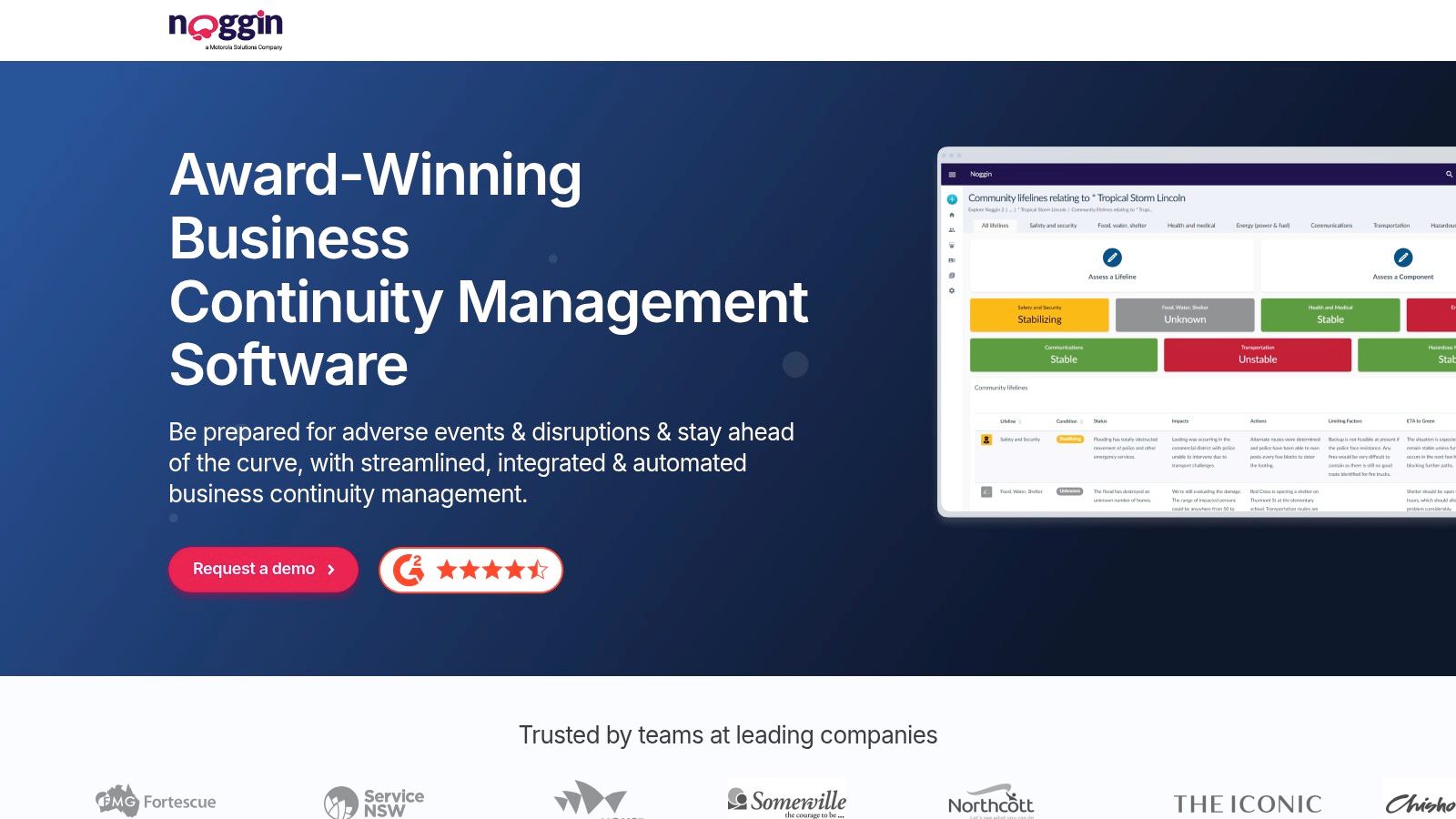
The platform is equipped with essential features like built-in BIA tools, dependency mapping, and guided plan execution. Users benefit from customizable reporting dashboards and extensive libraries of templates and role-based checklists, which help accelerate program implementation. This combination of powerful functionality and strong usability has earned Noggin significant third-party recognition in the operational resilience space.
Our Take
Defend IT Services View: For a San Antonio-based logistics company or a distributed healthcare provider, Noggin’s all-in-one resilience model is a major advantage. We can help configure its modular workspaces to align BCM with incident response protocols, ensuring that a supply chain disruption or a facility-level emergency triggers a coordinated, platform-driven recovery effort. Its availability on AWS Marketplace simplifies procurement for our cloud-focused clients.
| Feature Highlights | Assessment |
|---|---|
| Integrated Resilience | Excellent. Combines BCM with crisis and emergency management in one platform. |
| Configurability | Strong. Modular workspaces and custom dashboards adapt to specific business needs. |
| US Public Sector | Moderate. Has fewer public-sector references in the US compared to some established domestic vendors. |
Website: https://www.noggin.io/business-continuity-software
11. Quantivate – Business Continuity Management Software
Quantivate offers a comprehensive BCM and disaster recovery solution that is particularly popular with US financial institutions like banks and credit unions. Its strength lies in an all-in-one approach, combining planning, risk assessment, and reporting with a library of ready-to-use templates. For organizations needing to build compliant plans quickly, this platform provides a structured path, making it some of the best business continuity software for regulated mid-market companies.
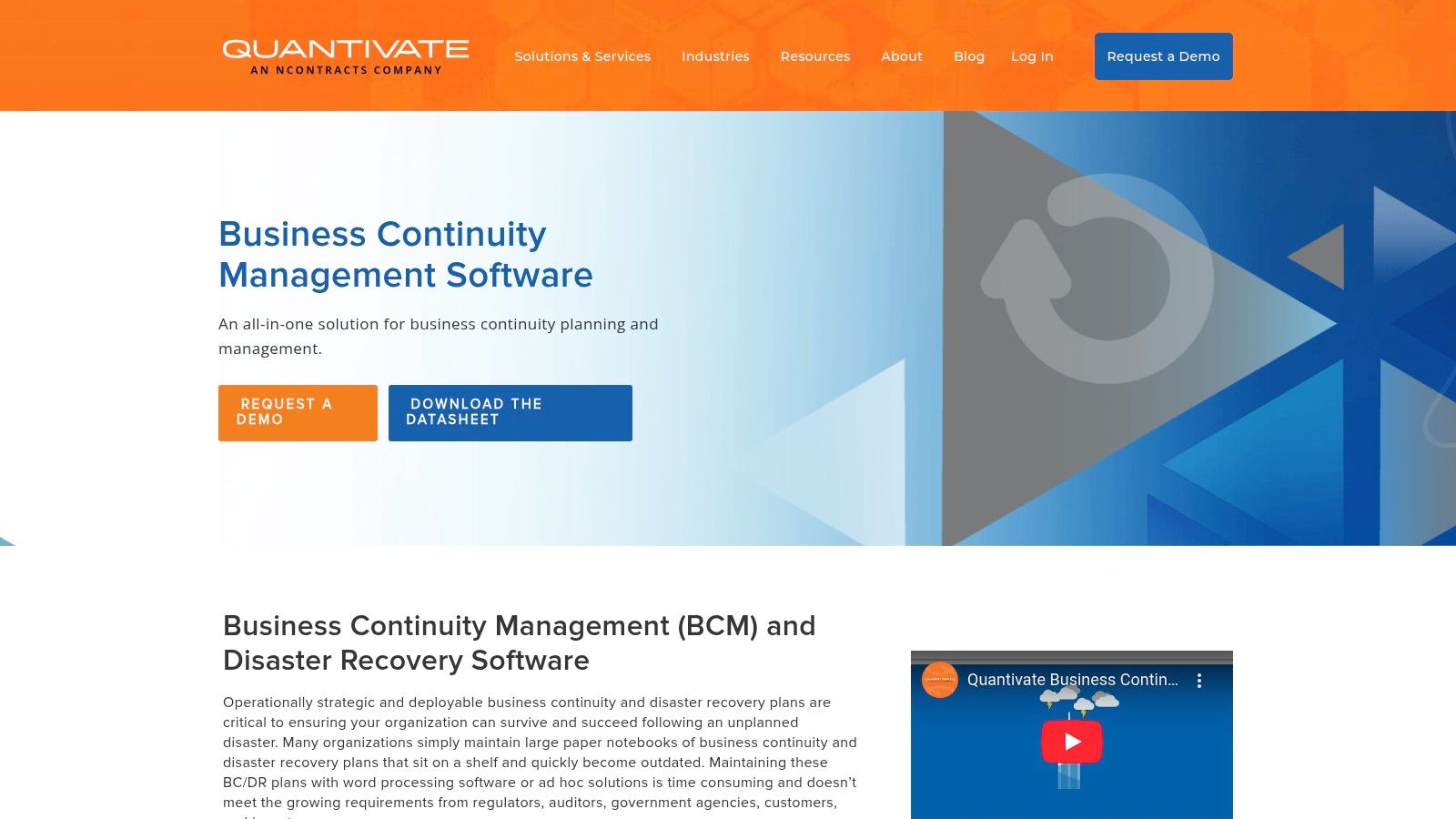
The platform streamlines the creation of diverse plans, including BC, COOP, DR, and even pandemic responses, using pre-built content that can be easily customized. It features a robust Business Impact Analysis (BIA) module and a powerful report builder to generate documentation for stakeholders and auditors. Its ability to integrate with other Quantivate GRC modules offers a unified view of organizational risk and resilience.
Our Take
Defend IT Services View: For San Antonio credit unions or regional banks we support, Quantivate is a go-to for meeting FFIEC and NCUA expectations. We can deploy the software to rapidly develop and manage their BIA and recovery plans, using the built-in templates to ensure all regulatory requirements are addressed, which simplifies the audit process and strengthens their overall compliance posture.
| Feature Highlights | Assessment |
|---|---|
| Plan Templates | Excellent. Speeds up plan development with a wide range of prebuilt, compliant content. |
| GRC Integration | Good. Connects BCM data with broader risk and compliance modules within the Quantivate ecosystem. |
| User Interface | Moderate. The UI is functional but can feel less modern compared to enterprise-grade competitors. |
Website: https://quantivate.com/business-continuity-software/
12. G2 – Business Continuity Management Software Category
Before committing to a platform, leveraging a B2B software marketplace like G2 is a critical due diligence step. G2's category for Business Continuity Management provides an aggregated view of the landscape, complete with verified user reviews, feature grids, and real-time satisfaction ratings. This makes it an invaluable resource for shortlisting vendors and comparing solutions based on authentic, hands-on feedback from real-world users rather than just marketing materials.
The platform allows you to filter solutions by company size, industry, and specific features, ensuring you focus only on relevant options. You can create side-by-side comparisons to quickly identify key differentiators in pricing, implementation, and support. For businesses trying to find the best business continuity software for their specific niche, G2 helps validate vendor claims and uncover potential pitfalls highlighted by peers, saving significant time in the procurement process.
Our Take
Defend IT Services View: We often guide our San Antonio clients to use G2 as an initial research tool. It empowers them to build a confident shortlist. For instance, a local law firm can filter for platforms with strong compliance features and positive reviews from other legal practices, ensuring their final choice is well-vetted by a community of similar users before we begin the integration and management process.
| Feature Highlights | Assessment |
|---|---|
| Verified User Reviews | Excellent. Provides authentic insights into real-world performance and customer support quality. |
| Comparison Tools | Robust. Side-by-side grids make it easy to evaluate features, pricing, and user satisfaction. |
| Vendor Transparency | Moderate. Be mindful of sponsored placements that can influence visibility. |
Website: https://www.g2.com/categories/business-continuity-management-software
Top 12 Business Continuity Software Comparison
| Solution | Core Features & Capabilities | User Experience & Quality ★ | Value Proposition 💰 | Target Audience 👥 | Unique Selling Points ✨ | Price Points 💰 |
|---|---|---|---|---|---|---|
| Defend IT Services — Managed Backup & Disaster Recovery (BCDR) for SMBs 🏆 | 24/7 proactive monitoring, regulatory-compliant backups, rapid recovery | ★★★★★ Local expert, hands-on customization | 💰 Tailored SMB solutions, bundled managed services | SMBs focused on data security & scaling | ✨ Veteran-owned, Datto tech, full managed services | 💰 SMB-friendly, consult-based |
| ServiceNow – Business Continuity Management | Business Impact Analysis, crisis activation, mass notification | ★★★★ Enterprise-grade dashboards & security | 💰 Enterprise-quoted pricing | Enterprises using ServiceNow | ✨ Integrated workflows & AI platform | 💰 Quote-based |
| Fusion Risk Management – Fusion Framework System | Visual dependency mapping, risk assessments, recovery orchestration | ★★★★ Mature workflows, practitioner resources | 💰 Enterprise-level customization | Large enterprises & resilience teams | ✨ Salesforce Lightning-based, end-to-end BCM | 💰 Custom |
| Everbridge – BC in the Cloud (Infinite Blue) & Crisis Management | Low-code plan templates, real-time incident response, notifications | ★★★★ Broad ecosystem & strong frameworks | 💰 Comprehensive BCM + CEM in one platform | Mid-large orgs needing mass notification | ✨ Integrated risk intel + crisis management | 💰 Enterprise |
| Riskonnect – Business Continuity & Resilience | Crisis management, threat intel, generative AI for BCP/BIA | ★★★★ Mobile apps, strong IRM+BCM integration | 💰 Enterprise focus, comprehensive IRM suite | Enterprises with complex risk needs | ✨ AI-assisted content, mobile incident command | 💰 Enterprise |
| SAI360 – Business Continuity Management (within GRC) | BIA, crisis management, dashboards, automated testing | ★★★★ Preconfigured modules, GRC integration | 💰 FastStart implementations, broad GRC coverage | Organizations needing BCM+ERM | ✨ Connected GRC platform, faster time-to-value | 💰 Mid-enterprise |
| Archer – Business Resiliency / Resilience Management | BIAs, crisis workflows, impact analysis | ★★★★ Strong auditability & governance | 💰 Requires dedicated admin & program design | Organizations standardizing on Archer IRM | ✨ Deep IRM lineage, robust reporting | 💰 Enterprise |
| LogicManager – Business Continuity Management Program | BIA/BCP authoring, workflow automation, advisory resources | ★★★★ Risk-based method, transparent pricing | 💰 Fixed price, unlimited user access | Risk-focused orgs wanting advisory | ✨ Satisfaction guarantee, risk-based approach | 💰 Fixed pricing |
| MetricStream – Business Continuity Management | BIA, crisis workflows, mobile access, AI issue management | ★★★★ Extensive analytics, third-party risk integration | 💰 Enterprise-grade BCM linked to compliance | Large enterprises with risk focus | ✨ Connected GRC, AI-assisted management | 💰 Enterprise |
| Noggin – Business Continuity Software | BIA, dependency mapping, custom analytics, role checklists | ★★★★ Strong usability & cloud marketplace presence | 💰 Modular resilience, award-winning usability | Organizations seeking configurable BCM | ✨ AWS Marketplace availability, resilience platform | 💰 Mid to enterprise |
| Quantivate – Business Continuity Management Software | Plan templates, BIA, risk assessment, GRC integration | ★★★★ Fast plan creation, regulator-focused | 💰 Popular with financial institutions | US financial institutions | ✨ Integrated GRC modules, template-rich | 💰 Mid-market |
| G2 – Business Continuity Management Software Category | User reviews, comparison grids, filters by size/industry | ★★★★ Large volume of verified user feedback | 💰 Free marketplace, vendor validation | Buyers researching BCM solutions | ✨ Buyer intent data, side-by-side comparisons | Free |
From Plan to Practice: Partnering for True Business Resilience
Navigating the landscape of the best business continuity software can feel overwhelming. We've explored a wide range of platforms, from comprehensive GRC suites like Archer and SAI360 to specialized crisis management tools like Everbridge and user-friendly solutions like LogicManager. Each offers a unique set of features designed to streamline planning, testing, and incident response, providing the technological backbone for organizational resilience.
The central takeaway is that there is no single "best" solution for every organization. The ideal platform depends entirely on your specific circumstances. A highly regulated financial institution in San Antonio may gravitate toward the robust compliance and risk management features of Riskonnect, while a growing multi-location healthcare provider might prioritize the incident management and communication capabilities of Noggin to ensure HIPAA compliance and patient safety during disruptions.
Key Considerations Before You Commit
Choosing a tool is only the first step. The true measure of a business continuity plan lies in its execution. Before making a final decision, consider these critical factors:
- Integration Complexity: How well will the software integrate with your existing technology stack, such as your help desk, IT service management (ITSM) tools, or HR systems? A lack of seamless integration can create data silos and hinder effective response.
- Implementation Resources: Do you have a dedicated internal team with the time and expertise to manage the implementation, configuration, and ongoing maintenance of the platform? Many of these powerful tools require significant upfront effort to align with your specific business processes.
- Scalability and Future Needs: Your business is not static. The software you choose today must be able to grow with you, whether you're planning a cloud migration, expanding to new locations, or facing evolving regulatory requirements.
The Human Element: Bridging the Gap Between Software and Success
Ultimately, even the most advanced business continuity software is just that: software. Its value is unlocked by the people and processes that support it. A plan that exists only on a digital dashboard is not a plan; it's a liability. True resilience is achieved when your technology is expertly configured, your plans are regularly tested through realistic drills, and your team is trained to respond effectively when a crisis hits.
This is where a managed services partner becomes invaluable. An expert partner translates your strategic BCM goals into technical reality, ensuring your chosen platform is not just installed but optimized, maintained, and integrated into your daily operations. This partnership transforms your software from a passive investment into an active, dynamic shield that protects your revenue, reputation, and regulatory standing. By bridging the gap between planning and practice, you build a resilient foundation that can withstand whatever comes next.
Ready to turn your business continuity plans into a state of constant readiness? Defend IT Services specializes in deploying, managing, and testing the very solutions discussed in this article, ensuring your investment delivers real-world protection. Contact us today to build a robust and resilient operational framework for your San Antonio business.
Article created using Outrank

